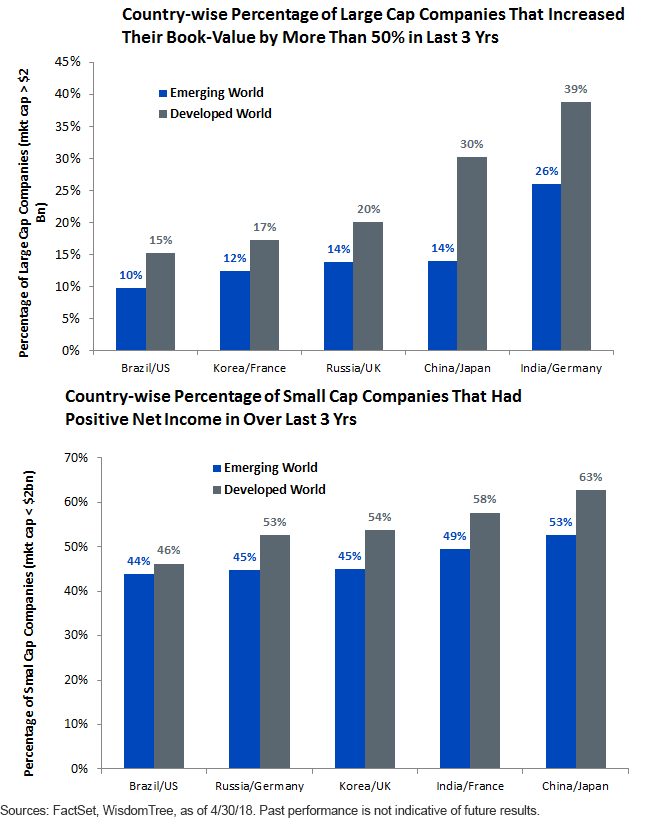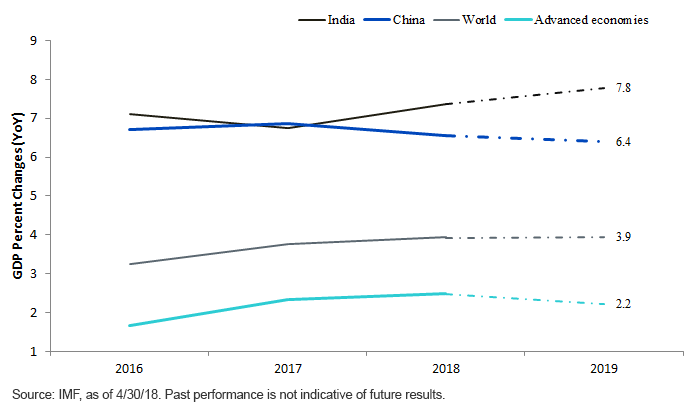Telltale Signs of Growth in the Current Cycle


After nearly a decade of loose monetary policy, we entered a phase of monetary tightening in December 2015 when the Federal Reserve (Fed) hiked interest rates for the first time in about a decade. The world depends on greenbacks, which fuel trade everywhere from New York to New Delhi and from London to Macau. More than half of all global cross-border debt is issued in dollars, and they make up almost two-thirds of global central bank reserves1. When the U.S. Federal Reserve changes course, it’s an event investors can’t ignore.
Below I analyze the top five developed and top five developing economies and their growth profiles.
Debunking the “Fed Increases Rates Causing Stronger Dollar, Weaker EM Equities” Notion
For starters, I want to debunk this notion that the Fed hiking path will universally lead to a stronger dollar and that this has been bad news for emerging markets (EM). As the exhibit below shows, in the last four out of five cycles when the Fed hiked rates, EM actually rallied and outperformed the S&P 500, while the MSCI EAFE did so twice. The correlation between Fed hikes and weaker international equities is weak at best.

For definitions of terms in the chart, please visit our glossary.
Fast Economies Lead to Faster Corporate Growth
Now, let’s focus more locally and check for countries that have outperformed. In the exhibits below, I look at companies, both large and small caps, in the top five developed and developing economies to focus on where maximum growth happened.
I evaluated the proportion of large-cap companies (market cap greater than $2 billion) that showed strong growth by increasing book value by more than 50% over the last three years. Similarly, I also looked for the proportion of small-cap companies (less than $2 billion market cap) that made positive cash flows and generated profits, again over the last three years.

Here are two quick observations:
1. EM—Indian and Chinese companies consistently fared better across large/small caps.
2. Developed world—Companies in export-oriented countries such as Japan, France and Germany fared better.
Next, let’s look at what, in my opinion, helped these companies.
Economic Growth Feeding Corporate Growth
To explore why certain countries did better than others, I show a rather simple chart of economic growth trends projected by the IMF.
Gross Domestic Product (GDP) Growth Rates (Past and Projected)

When I juxtapose this chart with corporate growth above, there are two primary takeaways:
- Countries like India and China, whose growth was nearly twice as fast as global growth, provided massive support for their large-cap companies to piggyback on and grow alongside. As their economies picked up, rewards percolated to all segments of society, and small-cap companies, which are typically tied more strongly to local consumption, benefitted and made more profits.
- For advanced economies, 2016 and 2017 were years when growth picked up pace, and this helped companies in countries running fiscal surpluses as they exported more goods to satisfy global demand. This led Japanese and German firms to grow and make profits as well.
Conclusion and Key Risks
There are a few conclusions here:
- Strategic investors should consider over-weighting countries that are growing fast (i.e., India and China). As fast economic growth is a strong tailwind to large-cap companies and as benefits of economic expansion percolate downward, small caps get a boost as well.
- Over-weighting export-oriented countries, especially Japan and Germany, could be a great way to play on global growth. Continued growth in global demand is likely going to be favorable to corporate earnings in these countries.
This is not to say there are no risks. The top risks I see:
- As institutions in EM are fragile, any change in sentiments can temporarily send EM equities on a downward trend. In my opinion, investors can mitigate such a risk by staying focused on fundamentally attractive and profitable companies. For instance, the WisdomTree India Earnings Fund (EPI), by ONLY selecting profitable companies and then weighting them by trailing 12-month profits, is, in our view, a smart way to invest in profitable companies with less expensive valuations. Similarly, the WisdomTree China ex-State-Owned Enterprises Fund (CXSE) is a strategy to invest with non-state-owned companies, thus gravitating to more companies in China that have more robust growth profiles.
- A rising dollar or rotation to safe-haven assets due to escalation in geopolitics can also put downward pressure on currencies, dragging equities down too. One way to partially hedge this risk is by removing currency exposure that comes with investing internationally. Because of the cheaper cost to hedge, hedging currency risk can be easier for developed countries and makes even more sense for export-oriented countries with trade surpluses, such as Japan and Germany. Investors should consider currency-hedged strategies from WisdomTree, which provide a great way to invest internationally while mitigating currency risk.
1Source: Bank of International Settlement, Economist as of 05/31/2018
Important Risks Related to this Article
There are risks associated with investing, including possible loss of principal. Foreign investing involves special risks, such as risk of loss from currency fluctuation or political or economic uncertainty. The Funds focus their investments in China and India thereby increasing the impact of events and developments associated with the region which can adversely affect performance. Investments in emerging or offshore markets are generally less liquid and less efficient than investments in developed markets and are subject to additional risks, such as risks of adverse governmental regulation and intervention or political developments. The Fund’s exposure to certain sectors may increases its vulnerability to any single economic or regulatory development related to such sector. As the Funds can have a high concentration in some issuers and can be adversely impacted by changes affecting those issuers. Please read the Fund’s prospectus for specific details regarding the Fund’s risk profile.
Hedging can help returns when a foreign currency depreciates against the U.S. dollar, but it can hurt when the foreign currency appreciates against the U.S. dollar.


